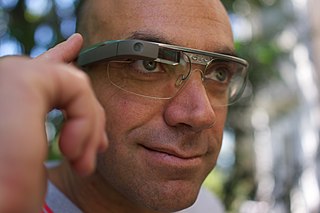Related Research Articles

A wearable computer, also known as a body-borne computer, is a computing device worn on the body. The definition of 'wearable computer' may be narrow or broad, extending to smartphones or even ordinary wristwatches.

Augmented reality (AR) is an interactive experience that combines the real world and computer-generated 3D content. The content can span multiple sensory modalities, including visual, auditory, haptic, somatosensory and olfactory. AR can be defined as a system that incorporates three basic features: a combination of real and virtual worlds, real-time interaction, and accurate 3D registration of virtual and real objects. The overlaid sensory information can be constructive, or destructive. As such, it is one of the key technologies in the reality-virtuality continuum.

A head-mounted display (HMD) is a display device, worn on the head or as part of a helmet, that has a small display optic in front of one or each eye. HMDs have many uses including gaming, aviation, engineering, and medicine.

A virtual retinal display (VRD), also known as a retinal scan display (RSD) or retinal projector (RP), is a display technology that draws a raster display directly onto the retina of the eye.

ARToolKit is an open-source computer tracking library for creation of strong augmented reality applications that overlay virtual imagery on the real world. Currently, it is maintained as an open-source project hosted on GitHub.
Vuzix is an American multinational technology company headquartered in Rochester, New York and founded by Paul Travers in 1997. Vuzix is a supplier of wearable virtual reality and augmented reality display technology. Vuzix manufactures and sells computer display devices and software. Vuzix head-mounted displays are marketed towards mobile and immersive augmented reality applications, such as 3D gaming, manufacturing training, and military tactical equipment. On January 5, 2015, Intel acquired 30% of Vuzix's stock for $24.8 million.

Recon Instruments was a Canadian technology company that produced smartglasses and wearable displays marketed by the company as "heads-up displays" for sports. Recon's products delivered live activity metrics, GPS maps, and notifications directly to the user's eye. Recon's first heads-up display offering was released commercially in October 2010, roughly a year and a half before Google introduced Google Glass.

An optical head-mounted display (OHMD) is a wearable device that has the capability of reflecting projected images as well as allowing the user to see through it. In some cases, this may qualify as augmented reality (AR) technology. OHMD technology has existed since 1997 in various forms, but despite a number of attempts from industry, has yet to have had major commercial success.

Skully was a brand of motorcycle helmet with a heads-up display and a rear-facing camera.

Smartglasses or smart glasses are eye or head-worn wearable computers. Many smartglasses include displays that add information alongside or to what the wearer sees. Alternatively, smartglasses are sometimes defined as glasses that are able to change their optical properties, such as smart sunglasses that are programmed to change tint by electronic means. Alternatively, smartglasses are sometimes defined as glasses that include headphone functionality.

Reality Labs, formerly Oculus VR, is a business and research unit of Meta Platforms that produces virtual reality (VR) and augmented reality (AR) hardware and software, including virtual reality headsets such as Quest, and online platforms such as Horizon Worlds. In June 2022, several artificial intelligence (AI) initiatives that were previously a part of Meta AI were transitioned to Reality Labs. This also includes Meta's fundamental AI Research laboratory FAIR which is now part of the Reality Labs - Research (RLR) division.

castAR was a Palo Alto–based technology startup company founded in March 2013 by Jeri Ellsworth and Rick Johnson. Its first product was to be the castAR, a pair of augmented reality and virtual reality glasses. castAR was a founding member of the nonprofit Immersive Technology Alliance.

Magic Leap, Inc. is an American technology company that released a head-mounted augmented reality display, called Magic Leap One, which superimposes 3D computer-generated imagery over real world objects. It is attempting to construct a light-field chip using silicon photonics.

Meta was a company that designed augmented reality products. The company was founded by Meron Gribetz in 2012, based on the "Extramissive spatial imaging digital eye glass" technology invented by Gribetz and Mann originally filed with the US Patent and Trademark office Jan 3, 2013.

Windows Mixed Reality (WMR) is a discontinued platform by Microsoft which provides augmented reality and virtual reality experiences with compatible head-mounted displays.

Microsoft HoloLens is an augmented reality (AR)/mixed reality (MR) headset developed and manufactured by Microsoft. HoloLens runs the Windows Mixed Reality platform under the Windows 10 operating system. Some of the positional tracking technology used in HoloLens can trace its lineage to the Microsoft Kinect, an accessory for Microsoft's Xbox 360 and Xbox One game consoles that was introduced in 2010.
uSens, Inc. is a Silicon Valley startup founded in 2014 in San Jose, California. The company builds interactive computer-vision tracking solutions. The uSens team has extensive experience in artificial intelligence (AI), computer vision, 3D Human–computer interaction (HCI) technology and augmented reality and virtual reality. uSens has been applying computer vision and AI technologies in AR/VR, Automotive and smartphones.

A virtual reality headset is a head-mounted device that uses 3D near-eye displays and positional tracking to provide a virtual reality environment for the user. VR headsets are widely used with VR video games, but they are also used in other applications, including simulators and trainers. VR headsets typically include a stereoscopic display, stereo sound, and sensors like accelerometers and gyroscopes for tracking the pose of the user's head to match the orientation of the virtual camera with the user's eye positions in the real world.

Meron Gribetz is an Israeli technology entrepreneur. He was the founder and CEO of Meta, a Silicon Valley technology company that produced augmented reality products, closed in 2019. He was a founder of Inner Cosmos, makers of a digital pill designed to re-balance brain networks, and continued as CEO As of 2023.
Project Iris is the codename for an unreleased augmented reality (AR) headset designed and developed by Google. It was intended to resemble ordinary eyeglasses and expected to be released in 2024, until its cancellation in early 2023.
References
- ↑ "The future of work is augmented reality paired with next-gen wearables". siliconrepublic.com. 13 Aug 2015.
- ↑ "Former Qualcomm Exec Roy Ashok Signals Shift to Scaling the Business". daqri. 10 Oct 2017. Archived from the original on 14 December 2017. Retrieved 13 December 2017.
- ↑ "Choose Your Reality: Virtual, Augmented or Mixed". recode.net. 27 Jul 2015.
- 1 2 "4D: A Next Generation Of Brand Engagement And Play". Forbes.com. 27 Nov 2013.
- ↑ "Tech scene takes hold in revitalized downtown L.A." latimes.com. 7 Mar 2015.
- ↑ Robertson, Adi (2019-09-13). "Augmented reality headset company Daqri is reportedly shutting down". The Verge. Retrieved 2019-11-19.
- ↑ "Another high-flying, heavily funded AR headset startup is shutting down". TechCrunch. 13 September 2019. Retrieved 2019-11-19.
- ↑ "A RoboCop Hard Hat For Industrial Workers". fastcoexist.com. 8 Oct 2014.
- ↑ "IoT ONE DAQRI Case Study". IoTONE.com.
- ↑ "Daqri connects QR codes to augmented reality". cnet.com. 23 Feb 2011.
- 1 2 "Augmented Reality: Daqri". wired.com. 5 May 2013.
- ↑ "Thinking About the Next Revolution". The New York Times . 4 Sep 2013.
- 1 2 "Augmented Reality Startup Daqri Raises $15M More, Troy Carter Joins Advisory Board". techcrunch.com. 4 Jun 2013.
- ↑ "DAQRI raises $15M to develop its augmented reality platform, will support Google Glass at launch". thenextweb.com. 4 Jun 2013.
- ↑ "Augmented Reality: Daqri unveils 4d Smart Helmet for industrial workforce".
- 1 2 "Siemens Expands Testing of Augmented-Reality Helmet". blogs.wsj.com/. 31 Jul 2017.
- ↑ "The Hardhat Of The Future Uses Google Glass-Like Technology, And It's Ready To Roll Now". businessinsider.com. 8 Sep 2014. Archived from the original on 18 October 2015. Retrieved 17 October 2015.
- ↑ "Android-powered smart hard hat comes with augmented reality features". engadget.com. 7 Sep 2014.
- ↑ "Intel shows helmet that gives you X-ray vision". cnet.com. 5 Jan 2016.
- ↑ "Daqri Smart Helmet: Augmented Reality for the Workplace". bloomberg.com. 26 Jun 2015.
- ↑ "Augmented Reality Experts Unveil Hardhat 2.0". wsj.com. 4 Sep 2014.
- ↑ "A 'Fitbit' for the brain tries to improve your focus". usatoday.com.
- ↑ "Daqri Has Acquired an EEG Headband Company to Integrate Their Tech into an Industrial Augmented Reality Helmet". 19 February 2015.
- ↑ "Daqri Buys Smart Headband Maker Melon". labusinessjournal.com. 13 May 2015.
- ↑ "DAQRI Acquires AR Pioneer ARToolworks". techcrunch.com. 19 Feb 2015.
- ↑ "DAQRI OPENS EUROPEAN HEADQUARTERS IN DUBLIN".
- ↑ "Augmented Reality Gets Real In Dublin". Archived from the original on 2015-09-06. Retrieved 2015-10-17.
- ↑ "Intel steals the show at CES 2016 with an inspired, futuristic keynote". 6 Jan 2016.
- ↑ "Daqri acquires 1066 Labs to power its augmented reality smart helmet". March 2016.
- ↑ "DAQRI: Augmented reality on the shopfloor". CNBC . 7 Jun 2016.
- ↑ "Daqri Smart Glasses are designed for your boss at your future factory". 25 Oct 2016.
- ↑ "An augmented reality company that raised over $130 million is laying off staff worldwide". Business Insider. Retrieved 2018-05-23.
- ↑ "DAQRI Focused on Growth as It Promotes Former Qualcomm Exec to CEO". WonderHowTo. Retrieved 2018-05-14.
- ↑ Dempsey, Gaia (2017-12-02). "DAQRI: Reflections on the Beginning". Gaia Dempsey. Retrieved 2018-05-14.
- ↑ "New DAQRI Boss Brings AR Bonafides, Perspective". IndustryWeek. 2017-12-08. Retrieved 2018-05-30.
- ↑ "Daqri Worksense lets workers tag and scan their environments in AR". VentureBeat. 2018-03-07. Retrieved 2018-05-14.
- ↑ "DAQRI: Another high-flying, heavily funded AR headset startup is shutting down". Tech Crunch. 2019-09-12. Retrieved 2019-09-13.